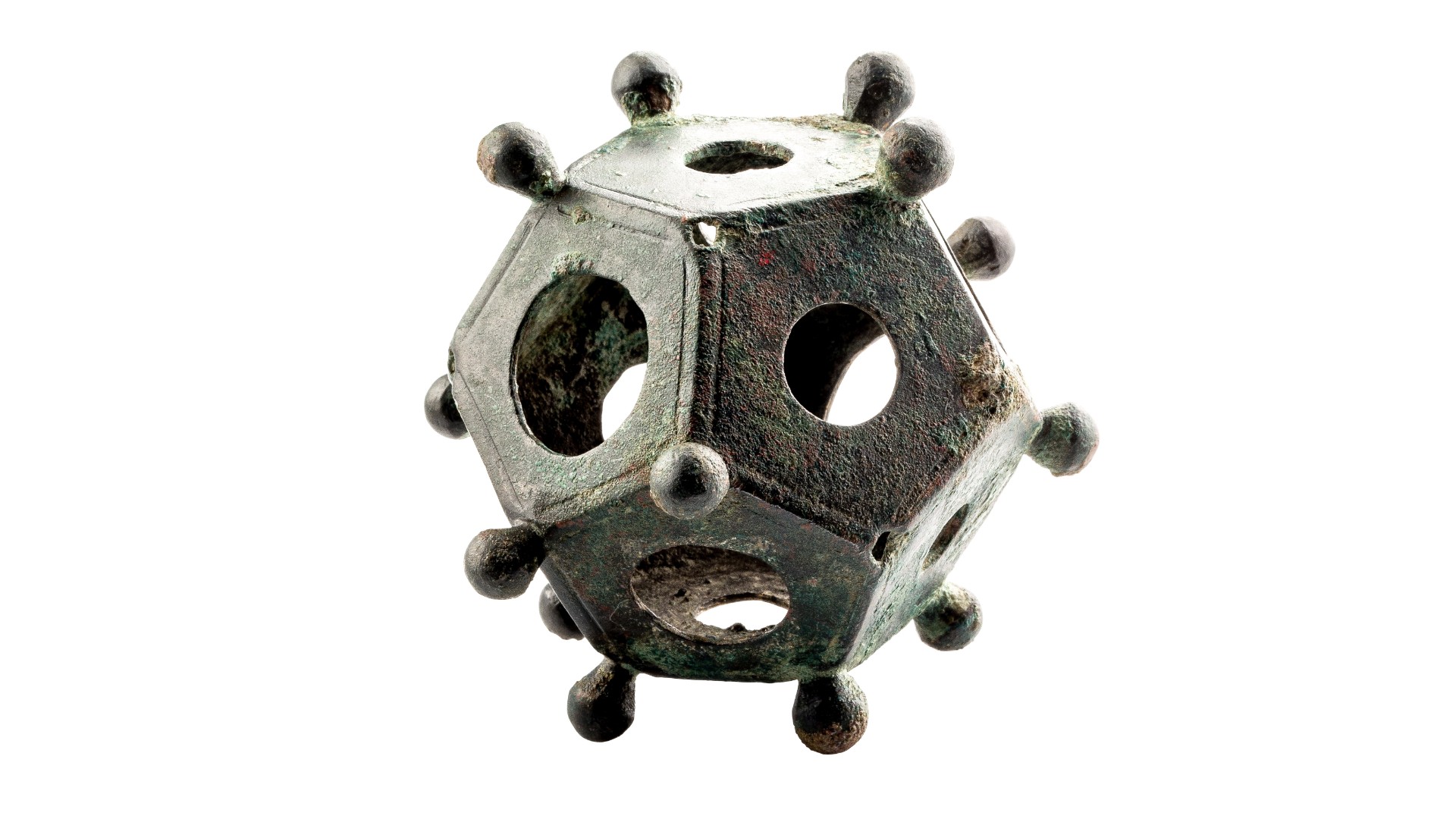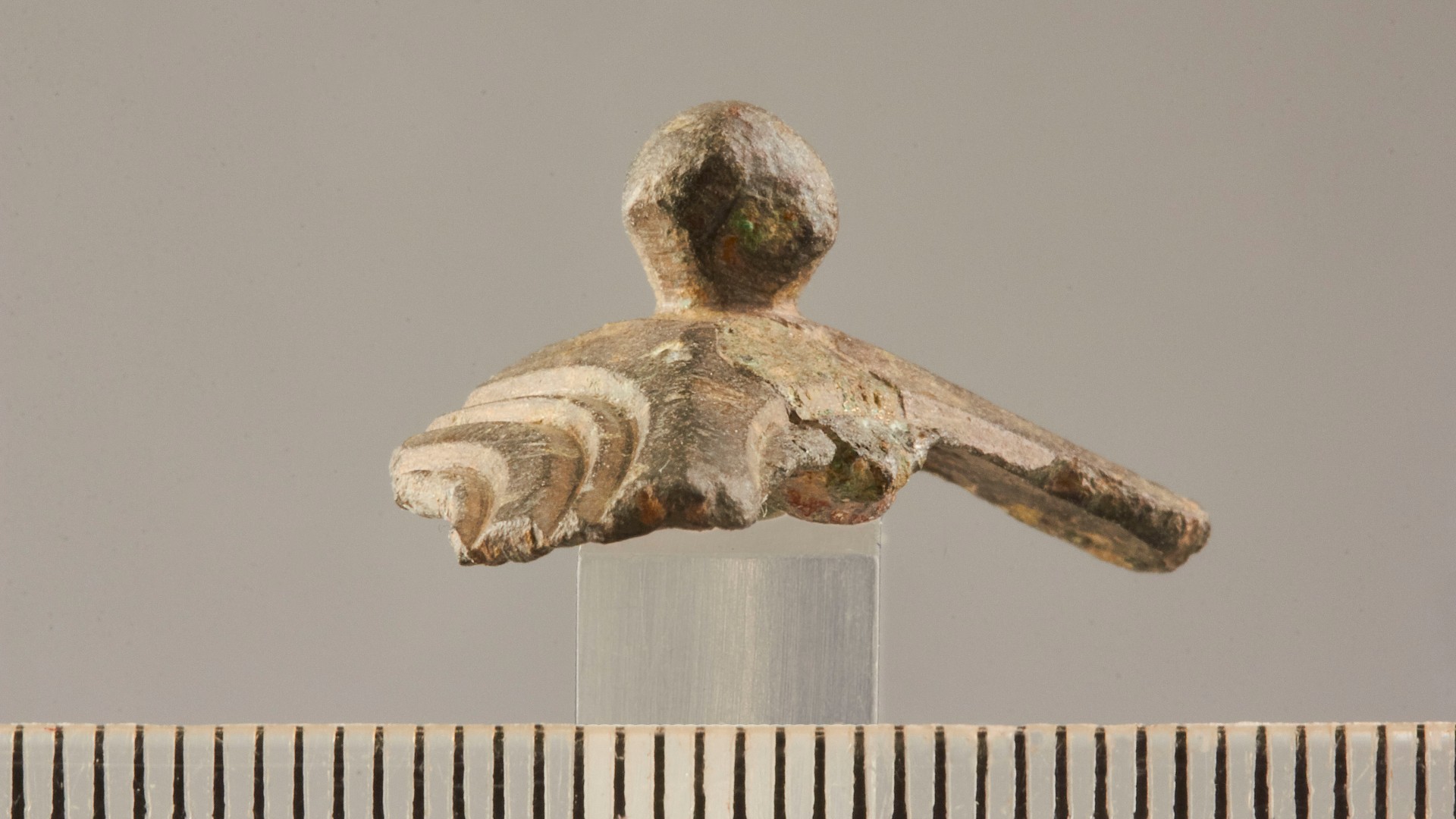Mysterious 12-sided Roman object found in Belgium may have been used for magical rituals
A fragment of a mysterious artifact known as a Roman dodecahedron has been found in Belgium.

A metal detectorist in Belgium has unearthed a fragment of a mysterious bronze artifact known as a Roman dodecahedron that is thought to be more than 1,600 years old.
More than a hundred of the puzzling objects — hollow, 12-sided geometric shells of cast metal about the size of baseballs, with large holes in each face and studs at each corner — have been discovered in Northern Europe over the past 200 years. But no one knows why or how they were used.
"There have been several hypotheses for it — some kind of a calendar, an instrument for land measurement, a scepter, etcetera — but none of them is satisfying," Guido Creemers, a curator at the Gallo-Roman Museum in Tongeren, Belgium, told Live Science in an email. "We rather think it has something to do with non-official activities like sorcery, fortune-telling and so on."
Creemers and his colleagues at the Gallo-Roman Museum were given the fragment by its finder and identified it in December. It consists of only one corner of the object with a single corner stud, but it is unmistakably part of a dodecahedron that originally measured just over 2 inches (5 centimeters) across.
Metal detectorist and amateur archaeologist Patrick Schuermans had found the fragment months earlier in a plowed field near the small town of Kortessem, in Belgium's northern Flanders region.
Related: Sacred chickens, witches and animal entrails: 7 unusual ancient Roman superstitions
Creemers said the Gallo-Roman Museum already displays a complete ancient bronze dodecahedron found in 1939 just outside Tongeren's Roman city walls, and the new fragment will go on display next to it in February.
Get the world’s most fascinating discoveries delivered straight to your inbox.
Mysterious dodecahedrons
The first Roman dodecahedron to be discovered in modern times was found in England in the 18th century, and roughly 120 have been found since then in Great Britain, the Netherlands, Belgium, France, Germany, Austria and Switzerland.
It's not possible to date the metal itself, but some dodecahedrons were found buried in layers of earth that date them to between the first and fifth centuries A.D.
The mystery doesn't end there; archaeologists cannot explain the geometric artifact's function, and no written record of the dodecahedrons has ever been found.
It's possible they were used in secret for magical purposes, such as divination (telling the future), which was popular in Roman times but forbidden under Christianity, the religion of the later Roman Empire, Creemers said. "These activities were not allowed, and punishments were severe," he explained. "That is possibly why we do not find any written sources."
Several explanations for the mysterious artifacts have been suggested over the years. Initially, they were described as "mace heads" and were thought to be part of a weapon. Other ideas are that they were tools for determining the right time to plant grain; that they were dice, or other objects for playing a game; and that they were instruments for measuring distance, possibly for finding the right range for Roman artillery, such as ballistas.
A recent suggestion is that dodecahedrons were knitting patterns for Roman gloves.
But most archaeologists think the objects were probably used in magical rituals. The dodecahedrons have no markings indicating how they were used, as might be expected for measuring instruments, and they all have different weights and sizes, ranging from 1.5 to 4.5 inches (4 to 11 centimeters) across.
Roman dodecahedrons are also found only in the Roman Empire's northwestern areas, and many were unearthed at burial sites. These clues suggest that the cult or magical practice of using them was restricted to the "Gallo-Roman" regions — the parts of the later Roman Empire influenced by Gauls or Celts, according to Tibor Grüll, a historian at the University of Pécs in Hungary who has reviewed the academic literature about dodecahedrons.
Related: The 5 craziest ways emperors gained the throne in ancient Rome
Ancient puzzle
Creemers said the dodecahedron fragment found near Kortessem could shed more light on these mysterious metal objects. Many other Roman dodecahedrons were first recognized for what they were in private or museum collections, so their archaeological context is unknown, he said.
But the location of the Kortessem fragment is well documented, he said; and subsequent archaeological investigations have revealed mural fragments at the site, indicating that it may have been a Roman villa.
A translated statement by the Flanders Heritage Agency said the fractured surfaces of the fragment indicate that the dodecahedron had been deliberately broken, possibly during a final ritual.
The location will now be monitored for further finds.
"Thanks to the correct working method of the metal detectorist, archaeologists know for the first time the exact location of a Roman dodecahedron in Flanders," the statement said. "That opens the door for further research."
Tom Metcalfe is a freelance journalist and regular Live Science contributor who is based in London in the United Kingdom. Tom writes mainly about science, space, archaeology, the Earth and the oceans. He has also written for the BBC, NBC News, National Geographic, Scientific American, Air & Space, and many others.





